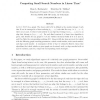Free Online Productivity Tools
i2Speak
i2Symbol
i2OCR
iTex2Img
iWeb2Print
iWeb2Shot
i2Type
iPdf2Split
iPdf2Merge
i2Bopomofo
i2Arabic
i2Style
i2Image
i2PDF
iLatex2Rtf
Sci2ools
131
Voted
IWPEC
2004
Springer
2004
Springer
Computing Small Search Numbers in Linear Time
Let G =
V; E
be a graph. The linear-width of G is de ned as the smallest integer k such that E can be arranged in a linear ordering
e1; : : : ; er
such that for every i = 1; : : : ; r ,1, there are at most k vertices both incident to an edge that belongs to fe1; : : : ; eig as to an edge that belongs to fei+1; : : : ; erg. For each xed constant k, a linear time algorithm is given, that decides for any graph G =
V; E
whether the linear-width of G is at most k, and if so, nds the corresponding ordering of E. Linear-width has been proven to be related with the following graph searching parameters: mixed search number, node search number, and edge search number. A consequence of this is that we obtain for xed k, linear time algorithms that check whether a given graph can be mixed, node, or edge searched with at most k searchers, and if so, output the corresponding search strategies.
Related Content
| Added | 02 Jul 2010 |
| Updated | 02 Jul 2010 |
| Type | Conference |
| Year | 2004 |
| Where | IWPEC |
| Authors | Hans L. Bodlaender, Dimitrios M. Thilikos |
Comments (0)

